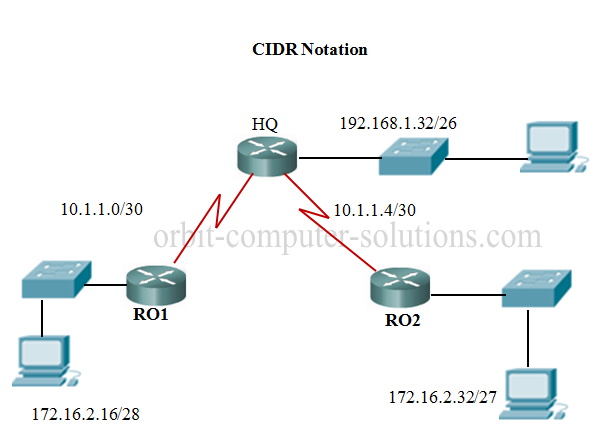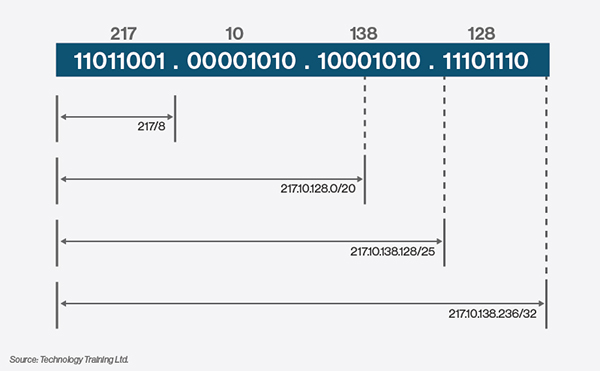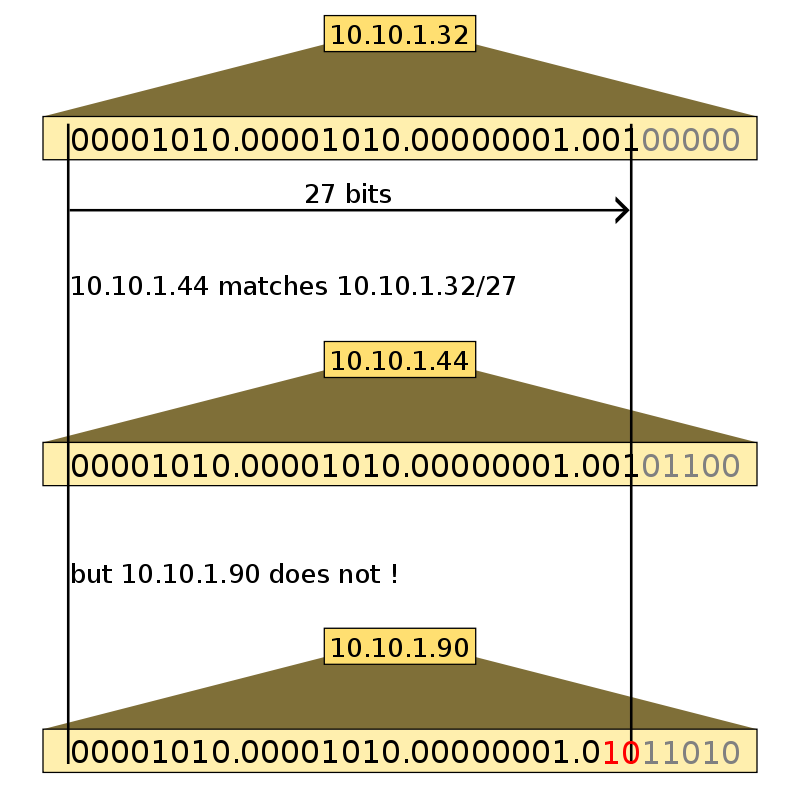CIDR (Classless InterDomain Routing)
CIDR (Classless Inter-Domain Routing) was introduced in 1993 (RCF 1517) replacing the previous generation of IP address syntax - classful networks. CIDR allowed for more efficient use of IPv4 address space and prefix aggregation, known as route summarization or supernetting.
CIDR introduction allowed for:
- More efficient use of IPv4 address space
- Prefix aggregation, which reduced the size of routing tables
CIDR allows routers to group routes together to reduce the bulk of routing information carried by the core routers. With CIDR, several IP networks appear to networks outside the group as a single, larger entity. With CIDR, IP addresses and their subnet masks are written as four octets, separated by periods, followed by a forward slash and a two-digit number that represents the subnet mask e.g.
10.1.1.0/30
172.16.1.16/28
192.168.1.32/27 etc.
CIDR / VLSM Network addressing topology example

CIDR uses VLSM (Variable Lenght Subnet Masks) to allocate IP addresses to subnetworks according to need rather than class. VLSM allows for subnets to be further divided or subnetted into even smaller subnets. Simply, VLSM is just subnetting a subnet.
With CIDR, address classes (Class A, B, and C) became meaningless. The network address was no longer determined by the value of the first octet, but assigned prefix length (subnet mask) address space. The number of hosts on a network, could now be assigned a specific prefix depending upon the number of hosts needed for that network.
Propagating CIDR supernets or VLSM subnets require a classless Routing Protocols – . A classless routing protocol includes the subnet mask along with the network address in the routing update.
Summary routes determination
Determining the summary route and subnet mask for a group of networks can be done in three easy steps:
- To list the networks in binary format.
- To count the number of left-most matching bits. This will give you the prefix length or subnet mask for the summarized route.
- To copy the matching bits and then add zero bits to the rest of the address to determine the summarized network address.
The summarized network address and subnet mask can now be used as the summary route for this group of networks. Summary routes can be used by both static routes and classless routing protocols. Classful routing protocols can only summarize routes to the default classful mask.
ISPs could now more efficiently allocate address space using any prefix length, ISPs were no longer limited to a- 255.0.0.0 or /8, 255.255.0.0 or /16, or 255.255.255.0 or /24 subnet mask which before the advent of CIDR is known as classful network addresses. Blocks of IP addresses could be assigned to a network based on the requirements of the customer, ranging from a few hosts to hundreds or thousands of hosts.
CIDR Advantages
With the introduction of CIDR and VLSM, ISPs could now assign one part of a classful network to one customer and different part to another customer. With the introduction of VLSM and CIDR, network administrators had to use additional subnetting skills.
The table below shows allowed subnet and Hosts IP address for all The Classes
| Subnet mask bits | Number of /24 subnets | Number of addresses | Bits stolen |
|---|---|---|---|
| /24 | 1 | 256 | 0 |
| /25 | 2 | 128 | 1 |
| /26 | 4 | 64 | 2 |
| /27 | 8 | 32 | 3 |
| /28 | 16 | 16 | 4 |
| /29 | 32 | 8 | 5 |
| /30 | 64 | 4 | 6 |
| /31 | 128 | 2 | 7 |
| Subnet Number | Network Address | First IP | Last IP | Broadcast Address |
|---|---|---|---|---|
| 1 | 2.2.2.0 | 2.2.2.1 | 2.2.2.6 | 2.2.2.7 |
| 2 | 2.2.2.8 | 2.2.2.9 | 2.2.2.14 | 2.2.2.15 |
| 3 | 2.2.2.16 | 2.2.2.17 | 2.2.2.22 | 2.2.2.23 |
| 32 | 2.2.2.249 | 2.2.2.250 | 2.2.2.254 | 2.2.2.255 |


